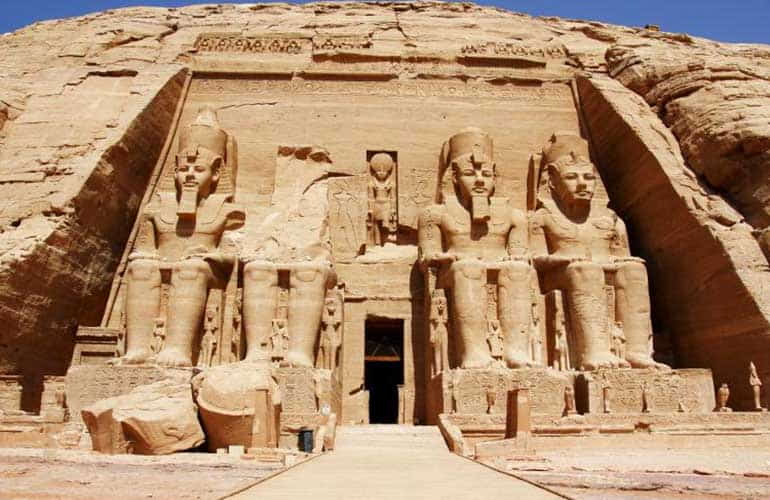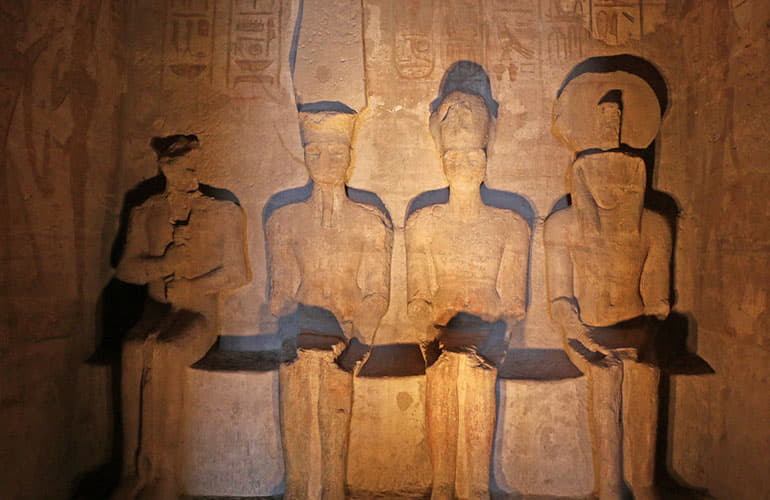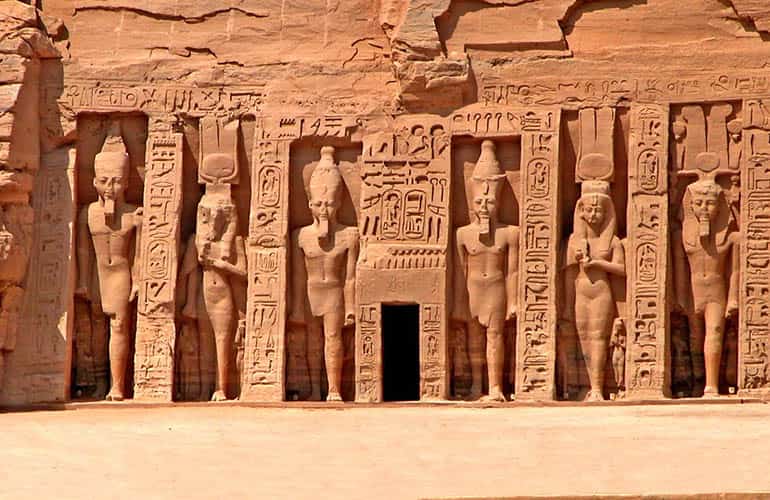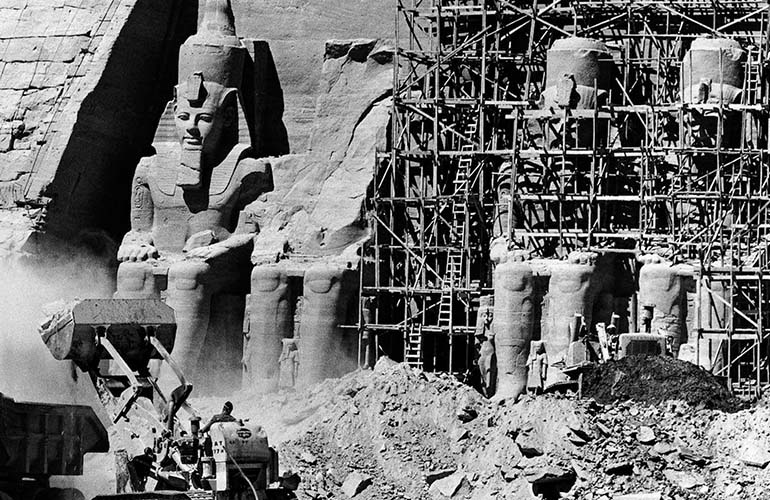Abu Simbel Temples, Aswan
Abu Simbel Temples is a complex formed by two temples excavated in the rock during the reign of Pharaoh Ramesses II in the 13th century BC, as a monument dedicated to this pharaoh and his wife Nefertari. It is located on the western shore of Lake Nasser, about 300 km by road from the Aswan dam, close to its original location.

Abu Simbel temple of Ramesses II
Abu Simbel temple Ramesses II was built by Ramesses II to commemorate his victory at the Battle of Kadesh. 1274 BC. Ramesses II, son of Seti I, fought the enemies of the North, and the South. His most important battle was the Battle of Kadesh against the Hittites [ Read more about ancient Egyptian wars ]. This battle ended with a peace treaty between the two forces. On the walls of Abu Simbel and other Egyptian temples, Ramesses II boasted of having won the battle.
Abu Simbel temples facts
Abu Simbel temple is dedicated to the worship of Ramesses himself and the great deities of ancient Egypt, Amon, Ra, and Ptah. These three gods were highly revered throughout the history of ancient Egypt. Ra was the head of the Ennead of Heliopolis, Amon the head of the Triad of Thebes and Ptah of craftsmen god of Memphis. Next to the three is represented Ramesses as the fourth great god of Egypt.
The facade of the Abu Simbel temple is 33 meters high by 38 meters wide and is guarded by four seated statues. All the statues represent Ramesses II, sitting on a throne with the double crown of Upper and Lower Egypt (Pschent crown Egypt).
Each of them is about twenty meters high and is headed by a frieze of twenty-two baboons, sun worshippers, which flank the entrance. The statues and the temple were sculpted on a rocky hill. The statue to the left of the entrance broke during an earthquake and only its bottom was left intact.
Near the feet of the giants, there are other statues that do not reach the height of the pharaoh’s knees. These represent various members of the Pharaoh’s family, such as his chief wife Nefertari, Queen Mother Tuya, his first two sons Amun-her-khepeshef, Ramesses, and his first six daughters Bintanath, Baketmut, Nefertari, Meritamen, Nebettawy and Isetnofret.
The entrance is crowned by a bas-relief depicting two images of the king worshipping Ra-Horajti with the head of a hawk, whose statue stands in a large niche. This god is holding a hieroglyph and a feather in his right hand, with Maat to his left.
The facade is headed by twenty-two baboons, whose arms are extended in the air, supposedly worshipping the rising sun. Another notable feature of the facade is a stele that records the marriage of Ramesses with a daughter of king Ḫattušili III, a union that sealed the peace between Egypt and the Hittites.
The interior of the Abu Simbel temple has the same layout as most ancient Egyptian temples, with rooms decreasing in size as you approach the sanctuary.
The hypostyle room is 18 meters long and 16.7 meters wide and is supported by eight large Osirian columns representing deified Ramesses linked to the god Osiris, the god of the underworld, to indicate the imperishable nature of the pharaoh.
The colossal statues along the left-hand wall carry the white crown of Upper Egypt (Hedjet), while those on the opposite side carry the double crown of Upper and Lower Egypt (Pschent crown Egypt).
Abu Simbel temple ” inside “
For most of the year, the inner sanctum of the main temple of Abu Simbel is shrouded in darkness. But twice a year, sunlight illuminates the seated statues of the sun gods Ra-Horakhty and Amon-Re, as well as a statue of Pharaoh Ramesses II, who had the temple built in his honor shortly after his ascension to the throne in 1279 BC.
On February 22 and October 22, the sun’s rays penetrate the structure of the great temple and illuminate part of the internal walls. In reality, this was the twenty-first of these months, but when the temple was moved to the artificial hills, its orientation could not be exactly reproduced.
Egyptologists speculate that it could coincide with the birthday and coronation of Ramesses II, who reigned for 66 years between 1279 and 1213 BC. An example of why the Egyptians did not build anything at random and that they were a very advanced civilization for their time.

Nefertari temple Abu Simbel
It is located north of the main temple and is dedicated to the goddess Hathor and Nefertari, who was the favorite wife of Ramesses II and was of Nubian origin. It is also carved into the sandstone. The facade is decorated with six statues, four of Ramesses II and two of Nefertari.
It is a real work of engineering very well preserved. Not only because of the spectacular nature of its enormous sculptures but also because of the quality of the inscriptions inside and the incredible skill that allowed, in those times, to control the entrance of sunlight on certain dates so that it illuminated certain parts, the triad in a chamber where the god of darkness was left in the dark
All six are of equal size with a size of 10 meters inside niches, something unusual since the statues representing the pharaoh used to be larger. The entrance leads to a room with six central columns, sculpted with capitals decorated with the head of the goddess Hathor.
The East Room contains some scenes showing Ramesses and his wife offering sacrifices to the gods. Behind this room is another room showing similar scenes. At the back of the temple is the sanctuary which contains a statue of the goddess Hathor.

Abu Simbel temple relocation:
As time passed, the abandoned temple began to fill with sand. About the sixth century B.C., the sand covered the statues of the main temple up to the height of their knees. Abu Simbel was forgotten until 1813, when the Swiss Johann Ludwig Burckhardt visited him.
As a result of the construction of the Aswan Dam in 1964, as Lake Nasser threatened to engulf the Abu Simbel Temples, UNESCO cut them from the mountain and moved them to an artificial cliff 210 m (688ft) back from and 65 m (213 ft) above their original position.

How to get to Abu Simbel temples?
To get to Abu Simbel temples there are several options, you can go by bus, by plane. You can also hire everything in different places. If you are going to cruise on Lake Nasser, you can skip the rest of the information, as the boat stops directly in front of the temples.
The plane is the fastest option, as it takes half an hour to get from Aswan to Abu Simbel. In the end, if we add up the time to go to the airport, the security control, the previous wait and the trip, it doesn’t save as much time as it might seem.
Competing in beauty and spectacularity with the Pyramids of Giza themselves, the temple of Abu Simbel is one of the most spectacular constructions in Egypt. See the temples of Abu Simbel of l on a daytime visit and be fascinated by their majesty in an evening sound and light show – Ancient Egypt in all its glory! [ Enjoy the best tour from Aswan to Abu Simbel ]





